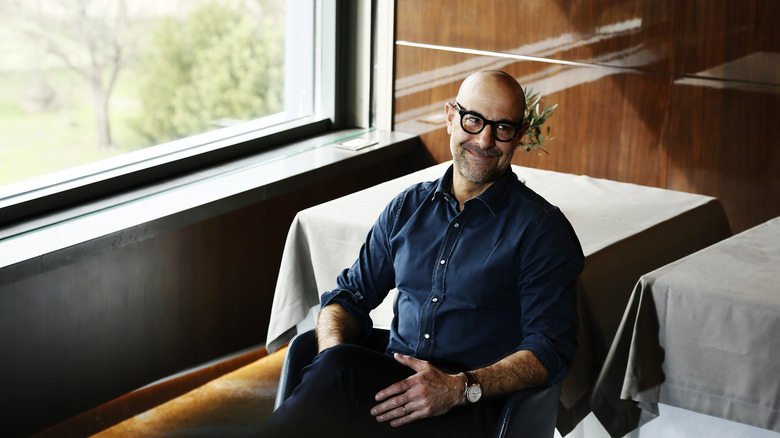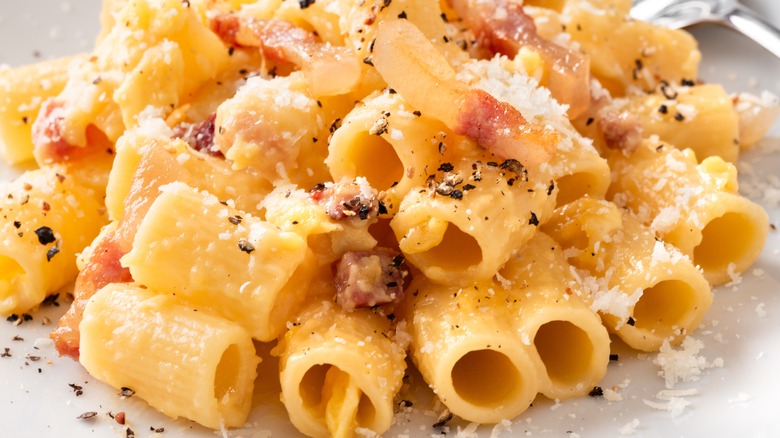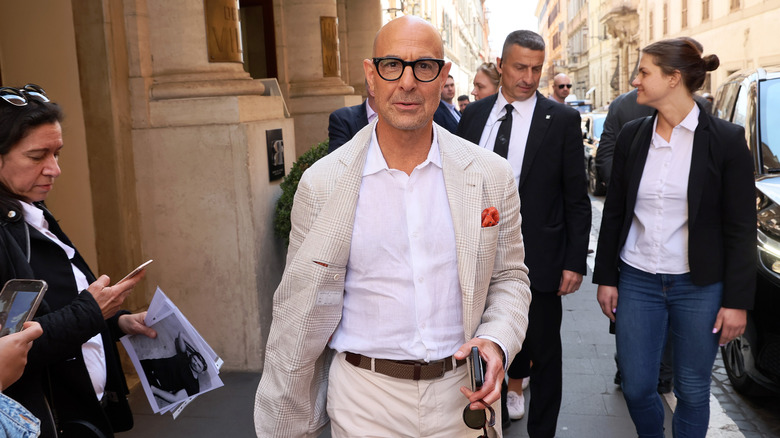The Iconic Food Stanley Tucci Will Only Order While He's In Italy
Spend some time traveling the world and it quickly becomes obvious that one of the best ways to learn about any destination is through the cuisine. From sampling the proclaimed original pad thai at the legendary Thipsamai in Bangkok to bravely ordering the sopi di yuana (iguana soup) at Jaanchie's in Curaçao, ordinary vacations are made significantly better and even more exciting when we dabble in native meals. The only problem, however, is that they're often never better than in those countries.
Just ask Stanley Tucci, an expert at finding the best pasta in Rome. In the second episode of his celebrated CNN series, "Stanley Tucci: Searching for Italy," the award-winning actor and television host visited the Eternal City to, among other things, find an authentic serving of pasta alla carbonara.
Dining at Pommidoro dal 1890 Ristorante, Tucci and his friends showcased ear-to-ear grins as they dug into the chef's heaping servings of this magnificent pasta dish, and the host even dinged some versions he has tried back home in the U.S. It comes as no surprise that he ultimately declared to Business Insider that he will never eat this pasta anywhere but in Rome. "It has to do with the quality of the ingredients and an understanding of the dish itself," he explained. "Italians, Romans know that better than anyone when it comes to this dish." Strong words for such a simple meal.
What's in a bowl of pasta alla carbonara?
As Tucci says in the episode (via CNN), following his first taste and subsequent wide grin of appreciation, "You have basically four ingredients: Pasta, eggs, the guanciale, and cheese." Guanciale is a cured pork jowl that Italians have enjoyed for centuries, and the local expertise is probably why it tastes so good in Rome.
In fairness, Tucci readily admits that even he cannot find a proper bowl of pasta alla carbonara at home that comes close to what he enjoyed while filming this episode. "When I try it at home, it's never this good," he says, before telling his companions that there always seems to be a secret to the authentic version. Pommidoro's Chef Daniele di Michele admitted to Tucci and his friends that her mother was very generous with her recipes — except she would always leave out one ingredient. Tucci said his mother did this as well, and that might explain why he has been so unimpressed by the efforts of the culinary teams at restaurants he visits in the States. Have U.S. chefs been mostly sabotaged by crafty nonnas?
But it's less about secrets and more about the ingredients, as we know that even Italy's most underrated cities have a knack for producing the best food items. "It is special because of the pork cheek and the way it is cured," Tucci told BI. "Also, the freshness of the eggs and the high quality of the Durham wheat pasta."
What other dishes does Stanley Tucci recommend?
"Stanley Tucci: Searching for Italy" was never intended to be a replacement for Anthony Bourdain's "Parts Unknown," but critics and viewers still loved it similarly for Tucci's fun style of informative travel advice. The actor's adventure, and series, began in Campania, where he checked in on a hidden-gem fried pizza spot that has had people buzzing for years: Pizza Fritte de Fernanda. In addition to the pasta alla carbonara, Tucci also devoured a serving of cacio e pepe at Bistrot64 in Rome, before indulging in the maritozzi at Bar San Calisto.
While you can basically plan an entire Italian vacation around Tucci's food tips from the two seasons of this series, the key to culinary bliss lies in Bologna — the food capital of Italy, and maybe even the world. Here, Tucci enjoyed a cooking lesson from Barbara Asioli at the legendary Casa Artusi, where visitors can learn how to make their own traditional dishes. Asioli walked the host through the process of making Bolognese ragu the same way Italian culinary icon Pellegrino Artusi made it.
And it's not always about the food. In Tuscany, Tucci and his guide ventured on a wine-focused bar-hopping experience that started at Babae, which boasts an extensive wine and signature cocktail menu, as well as an authentic "buchette del vino." These "little wine holes" date back to the Italian Renaissance and allowed busy Florentines to simply reach in and grab some wine on the go.


